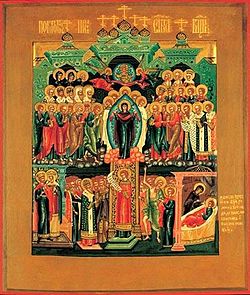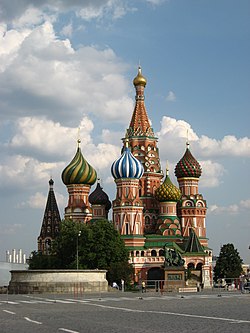Intercession of the Theotokos

The Intercession of the Theotokos, or the Protection of Our Most Holy Lady Theotokos and Ever-Virgin Mary, is a Christian feast of the
The feast is commemorated in
Etymology
The Protection of the Theotokos or the Intercession of the Theotokos (
: Σκέπη, Sképē) has a complex meaning. First of all, it refers to a cloak or shroud, but it also means protection or intercession. For this reason, the name of the feast is variously translated as the Veil of Our Lady, the Protecting Veil of the Theotokos. It is often translated as Feast of the Intercession or Feast of the Holy Protection.With some reservations, the Intercession icon may be related to the Western Virgin of Mercy image, in which the Virgin spreads wide her cloak to cover and protect a group of kneeling supplicants (first known from Italy from about 1280).
Tradition


According to Eastern Orthodox
St. Andrew turned to his disciple, St. Epiphanius, who was standing near him, and asked, "Do you see, brother, the Holy Theotokos, praying for all the world?" Epiphanius answered, "Yes, Holy Father, I see it and am amazed!"[1]
| Part of a series on the |
| Eastern Orthodox Church |
|---|
| Overview |
According to the
Veneration of the Intercession (Pokrov) in Rus' (and consequently Belarus, Russia, and Ukraine) dates back to the 12th century.
Icon
The icon of the feast, which is not found in
Feast

The Feast of the Intercession commemorates the miracle as a joyous revelation of the Theotokos' protection, which is spread over the world, and the Mother of God's great love for mankind.
In
Some, but not all, regions of the
It is not a part of the ritual traditions of, and therefore is not celebrated by, the Oriental Orthodox Churches or some jurisdictions that allow Western Rite Orthodoxy. Yet the feast is perfectly consistent with the theology of these sister churches. The Western Rite Communities of the Russian Orthodox Church Outside of Russia (ROCOR) do celebrate this feast on their calendar.[4]
October 1 (in the Julian calendar) is also the feast of St.
which have been attributed to him.The feast day of
Churches dedicated to the Intercession
Churches with that name are numerous in the East Slavic Orthodoxy.


In

Probably the most famous
Other notable churches commemorating this feast are Intercession of the Holy Virgin Russian Orthodox Church in
In north Wales there is the Church of the Holy Protection (Eglwys yr Amddiffyniad Sanctaidd) at 10 Manod Road, Blaenau Ffestiniog, where the liturgy is celebrated partly in Welsh, also English, Greek, and Church Slavonic. The church, under Igoumen Deiniol, is under the omophor of the diocese of Sourozh of the Moscow Patriarchate.
See also
- Blachernitissa
- Western Mater Misericordia imagery
- The Protecting Veil, a musical work by John Tavener, inspired by the Orthodox feast
References
- ^ a b c "Holy Protection of the Virgin Mary". Protection of the Blessed Virgin Mary Ukrainian Catholic Church. Archived from the original on January 5, 2014. Retrieved October 16, 2013.
- ^ Demchinsky, Sterling. "Icons of the Theotokos (Bohoroditsia)". Ukrainian Churches of Canada. Retrieved October 16, 2013.
- ^ ISBN 90-04-07809-6
- ^ a b "Protection of the Holy Virgin", Tranfiguration of Our Laord Russian Orthodox Church, Baltimore, Maryland
- ^ a b "Feast of Intercession Celebrated in Ukraine as Religious and National Holiday". RISU – Religious Information Service in Ukraine. October 14, 2012. Retrieved October 16, 2013.
- ^ "14 жотвня: Покрова Пресвятої Богородиці, День українського козацтва, народини УПА, День захисника України – Рідна країна". Рідна країна – світоглядний портал. October 14, 2019. Retrieved March 16, 2022.
- Verkhovna Rada of Ukraine. August 7, 1999. Retrieved October 16, 2013.
- ISBN 978-0300109122. p. 126.
- ^ St. Petersburg website. Accessed February 7, 2010.
- ^ Pokrov Church of the Russian Orthodox church website from UK. Accessed February 7, 2010.
Bibliography
- Покров Пресвятой Богородицы (in Russian) The article was used for iconography description.
- Basil Lourié. The Feast of Pokrov, its Byzantine Origin, and the Cult of Gregory the Illuminator and Isaac the Parthian (Sahak Partcev) in Byzantium
External links
- Celebration of Pokrov in Russia
- Icons of the Intercession
- The Protection of our Most Holy Lady the Mother of God and Ever-Virgin Mary Icon and Synaxarionof the feast
- The Feast of the Holy Skepi of the Theotokos from the Website of the Greek Orthodox Archdiocese of America
- Saint Andrew, Fool-for-Christ
- (in Russian) Pokrovsko-Vasil'evsky monastyr (Protection-Basil monastery)
- Pokrov Foundation, a Bulgarian Orthodox Christian organization
